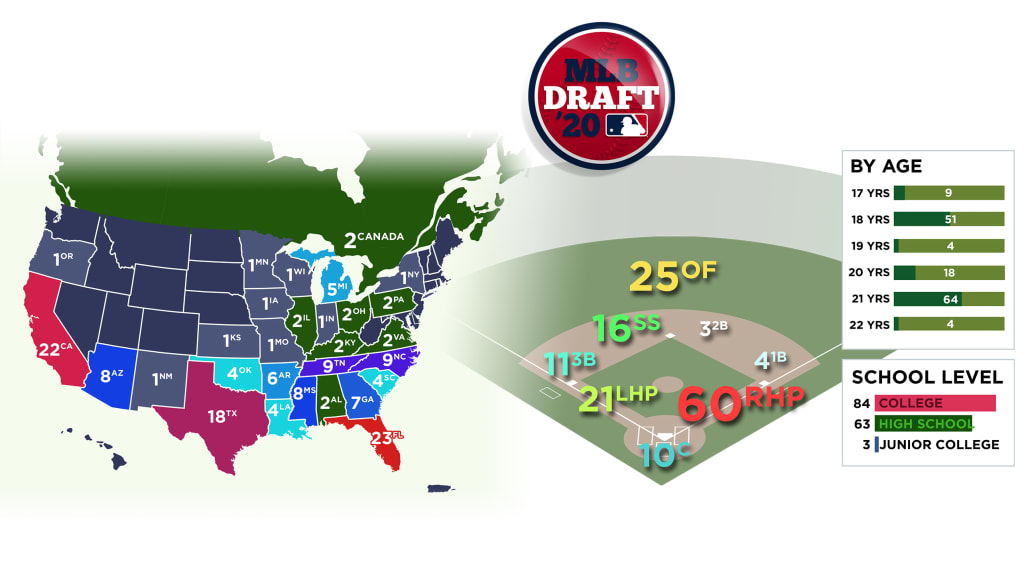Under normal circumstances, scouting departments from all 30 organizations would be scouring the country these days, evaluating all of the talent the Draft class of 2020 has to offer. These are, of course, far from normal circumstances.
Even with the date and number of rounds of this year’s Draft still unknown, teams are hard at work sorting out what this year’s Draft crop looks like. Video is being watched, reports are being checked, conference calls are being held on a daily basis and Draft boards are starting to come into shape. That work is reflected in the newly released Draft Top 150 prospects, a list that will expand to 200 in the coming weeks.
Like the Top 100 list that came out in December, the very top of the Draft is college-heavy. There is a new No. 1 prospect -- Arizona State first baseman Spencer Torkelson, up from No. 2 -- and the top six players all hail from the college ranks, four bats and two arms. There’s only one high schooler in the Top 10, fast-rising Florida prep outfielder Zac Veen.
- Spencer Torkelson, 1B, Arizona St.
- Austin Martin, OF/3B, Vanderbilt
- Asa Lacy, LHP, Texas A&M
- Emerson Hancock, RHP, Georgia
- Nick Gonzales, SS/2B, New Mexico St.
- Garett Mitchell, OF, UCLA
- Zac Veen, OF, Spruce Creek HS (Fla.)
- Reid Detmers, LHP, Louisville
- Max Meyer, RHP, Minnesota
- Heston Kjerstad, OF, Arkansas
Complete list »
“The top of the Draft is solid this year with productive Major League-caliber bats at various positions,” a National League scouting director said about the college hitters. “I think the college arms that are going up there are established, too, with Major League-caliber stuff and the credentials to back up their Draft rankings.”
Those credentials are always good to have, but are even more essential given how short-lived the spring was. Players are largely going to be drafted based on track record, and players who have a longer resume of success are more likely to be taken up top.
“They’re all good players,” the NL scouting director said. “It matters this year more than any other year I’ve worked the Draft that all of those guys have talent along with the results to back it up, which makes the process of selecting them much easier given the circumstances and the dynamics of this year’s Draft.”
College arms are certainly a strength, with 18 in the Top 50, especially when compared to last year’s group of 10. It’s typical for those college pitchers to float up and high school arms to sink a little once the Draft occurs, as teams often worry about the high-risk aspect of prep pitchers. Even with the trio of top high school pitching this year -- Mick Abel in Oregon (Jesuit HS), Jared Kelley in Texas (Refugio HS) and Nick Bitsko in Pennsylvania (Central Bucks HS) -- all ranking in the Top 15 talent-wise, it remains to be seen who will be willing to take the plunge on them given the overall uncertainty surrounding this Draft.
“Kelley, Abel and Bitsko are kind of wild cards in this year’s Draft because you don’t know how teams are going to be able to spend their Draft pools and be willing to take the risk involved with players like high school pitchers,” the NL scouting director said. “Do you take them? I don’t know. It’s going to be an interesting story to see how every team goes about drafting this year, whether they go conservative and safe or take a risk on a player they didn’t think they’d get there.”
"This Draft is heavy on elite-level arms, particularly college arms, so that's going to push down the other arms,” an American League scouting executive said. “Conversely, I think the position players -- both high school and college -- are going to get a position-scarcity bump. Particularly middle infielders, who are a really thin part of this class."
Indeed, there are only two middle infielders in the top 30, with New Mexico State’s Nick Gonzales in the top five and high schooler Ed Howard (Mount Carmel HS, Ill.) coming in at No. 16. There are just seven in the top 100 and while it picks up a bit in the 101-150 (11 more potential infielders), that’s still just 17 out of 150. And not all, including Gonzales at the top, are expected to play shortstop at the next level.
Now would typically be when things like future positions might be answered more fully. Teams have rapidly adapted to the reality of this year’s situation and seem ready to go, even without those extra looks.
"This is the point in the year where you really get a sense of guys, and now I don't know,” another AL scouting executive said. “The guys who were seen, that's where your comfort level will be. The college pitchers are still going to go good. With the high school players, the Team USA guys have an advantage because you've seen them."

BREAKDOWN
College: 84
HS: 63
JC: 3
RHP: 60
OF: 25
LHP: 21
SS: 16
3B: 11
C: 10
1B: 4
2B: 3
